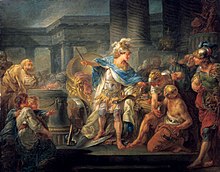
Back Knoop (tou) Afrikaans Nyudo (lazo) AN عقدة Arabic Chinu Aymara Düyün Azerbaijani Възел Bulgarian গিঁট Bengali/Bangla Nus (llaç) Catalan Uzel Czech Тĕвĕ CV

- Yarn knot (ABoK #2688)
- Manrope knot (ABoK #847)
- Granny knot (ABoK #1206)
- Wall and crown knot (ABoK #670, #671)
- Matthew Walker's knot (ABoK #681)
- Shroud knot (ABoK #1580)
- Turk's head knot (ABoK #1278-#1397)
- Overhand knot, Figure-of-eight knot (ABoK #514, #520)
- Reef knot, Square knot (ABoK #1402)
- Two half-hitches (ABoK #54)

A knot is an intentional complication in cordage[1] which may be practical or decorative, or both. Practical knots are classified by function, including hitches, bends, loop knots, and splices: a hitch fastens a rope to another object; a bend fastens two ends of a rope to each another; a loop knot is any knot creating a loop; and splice denotes any multi-strand knot, including bends and loops.[2] A knot may also refer, in the strictest sense, to a stopper or knob at the end of a rope to keep that end from slipping through a grommet or eye.[3] Knots have excited interest since ancient times for their practical uses, as well as their topological intricacy, studied in the area of mathematics known as knot theory.





- ^ Ashley, Clifford W. (1944), The Ashley Book of Knots, New York: Doubleday, p. 12,
The word knot has three distinct meanings in common use. In the broadest sense it applies to all complications in cordage, except accidental ones, such as snarls and kinks, and complications adapted for storage, such as coils, hanks, skeins, balls, etc.
- ^ Ashley, Clifford W. (1944), The Ashley Book of Knots, New York: Doubleday, p. 12
- ^ Ashley, Clifford W. (1944), The Ashley Book of Knots, New York: Doubleday, p. 12,
In its second sense it does not include bends, hitches, splices, and sinnets, and in its third and narrowest sense the term applies only to a knob tied in a rope to prevent unreeving, to provide a handhold, or (in small material only) to prevent fraying.
- ^ Anthropological Papers of the American Museum of Natural History. Material culture of the Blackfoot Indians. 1910.
© MMXXIII Rich X Search. We shall prevail. All rights reserved. Rich X Search